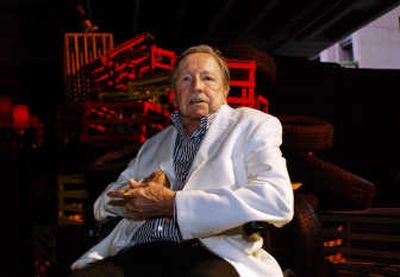‘Combines’ artist Rauschenberg dies at age of 82

TAMPA, Fla. – Pop artist Robert Rauschenberg’s mediums knew few bounds.
One of his most famous works or “combines” was “Bed,” created when he woke up in the mood to paint but had no money for a canvas. His solution was to take the quilt off his bed and use paint, toothpaste and fingernail polish for his creation. He was also a sculptor and a choreographer.
Rauschenberg died Monday of heart failure at 82, it was announced Tuesday by Jennifer Joy, his representative at PaceWildenstein gallery in New York. His use of odd and everyday articles earned him regard as a pioneer in pop art, first gaining fame in the 1950s.
“The most famous thing he said was that he worked in the gap between art and life,” said John Elderfield, chief curator of painting and sculpture at New York’s Museum of Modern Art. “I think what he meant by this is life was his materials as much as art was his materials.”
Rauschenberg didn’t mine popular culture wholesale as Andy Warhol (Campbell’s soup cans) and Roy Lichtenstein (comic books) did, but his combines – incongruous combinations of three-dimensional objects and paint – shared pop’s blurring of art and objects from modern life.
He also responded to his pop colleagues and began incorporating up-to-the-minute photographed images in his works in the 1960s, including, memorably, pictures of John F. Kennedy. He even won a 1984 Grammy Award for best album package for the Talking Heads album “Speaking in Tongues.”
“I’m curious,” he said in 1997 in one of the few interviews he granted in later years. “It’s very rewarding. I’m still discovering things every day.”
Nan Rosenthal, who curated “Robert Rauschenberg: Combines,” a joint exhibition by New York’s Metropolitan Museum of Art and the Museum of Contemporary Art, Los Angeles, called Rauschenberg a “tremendously imaginative artist.”
Rosenthal said she believed Rauschenberg would be best remembered for his series of all-white, all-black and all-red paintings, as well as the combines. The Met owns about 25 Rauschenberg paintings and about 75 drawings and prints.
“A lot of the time he was tremendously ebullient, a kind of irrepressible person,” who was also “quite a wonderful host and cook,” she said.
Time magazine art critic Robert Hughes, in his book “American Visions,” called Rauschenberg “a protean genius who showed America that all of life could be open to art. … Rauschenberg didn’t give a fig for consistency, or curating his reputation; his taste was always facile, omnivorous and hit-or-miss, yet he had a bigness of soul and a richness of temperament that recalled Walt Whitman.”
Born Milton Rauschenberg in 1925 in Port Arthur, Texas, and raised a Christian fundamentalist, Rauschenberg wanted to be a minister but gave it up because his church banned dancing.
“I was considered slow,” he once said.
“While my classmates were reading their textbooks, I drew in the margins.”
He was drafted into the U.S. Navy during World War II and knew little about art until a chance visit to an art museum where he saw his first painting at age 18. He drew portraits of his fellow sailors for them to send home.
When his time in the service was up, Rauschenberg used the GI Bill to pay for art school. He changed his name to Robert because it sounded more artistic.
In recent years he founded the organization Change Inc., which helps artists pay medical bills.
“I don’t ever want to go,” he told Harper’s Bazaar in 1997 when asked of his own death. “I don’t have a sense of great reality about the next world; my feet are too ugly to wear those golden slippers. But I’m working on my fear of it. And my fear is that something interesting will happen, and I’ll miss it.”